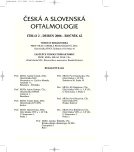Optical Coherence Tomography in Pars Plana Vitrectomy for Idiopathic Macular Hole
Authors:
I. Cihelková 1; P. Souček 1,2; J. Šach 1
Authors‘ workplace:
Oční klinika FNKV a 3. LF UK, Praha
přednosta prof. MUDr. P. Kuchynka, CSc.
1; Katedra oftalmologie IPVZ, Praha
vedoucí prof. MUDr. P. Kuchynka, CSc.
2; Ústav patologie FNKV a 3. LF UK, Praha
přednosta prof. MUDr. Václav Mandys, CSc.
3
Published in:
Čes. a slov. Oftal., 62, 2006, No. 2, p. 100-109
Overview
26 eyes of 25 patients after macular hole surgery were followed-up for 6 months in average (range of 2-25 months). The overall anatomic success rate was 77 %. The internal limiting membrane was peeled after its staining with trypan blue in all closed macular holes. The macular hole surgery resulted in anatomic success of stage Ib or II in 11 (100 %) eyes, of stage III in 7 (64 %) eyes and in stage IV in 2 (50 %) eyes.
There was an improvement or a stabilisation of the best corrected visual acuity (BCVA) in 85 %. BCVA improved from 4/20 to 4/12 in average. 45 % of patients with closed macular hole attained BCVA 4/10 or better, 5 (25 %) of them with the best visual acuity at presentation improved to 4/8 in average.
In 23 % cases of clinically normal fellow eyes, optical coherence tomography (OCT) detected an abnormality of the vitreoretinal surface.
OCT is essential for evaluation of anatomical success after macular hole surgery. It is necessary to perform it also in a fellow eye to exclude clinically silent abnormality of the vitreoretinal surface.
Key words:
optical coherence tomography, idiopathic macular hole, internal limiting membrane peeling, trypan blue, betamethasone
Labels
OphthalmologyArticle was published in
Czech and Slovak Ophthalmology

2006 Issue 2
Most read in this issue
- Vernal Keratoconjunctivitis and Possibilities its Treatment
- The Orbital Implant after Exenteration of the Orbit with the Preservation of the Eyelids and the Conjunctival Sac
- The Influence of IOL Implantation on Visual Acuity, Contrast Sensitivity and Colour Vision 2 and 4 Months after Cataract Surgery
- Bilateral Retinal Vasculitis with Arterial Aneurysms
